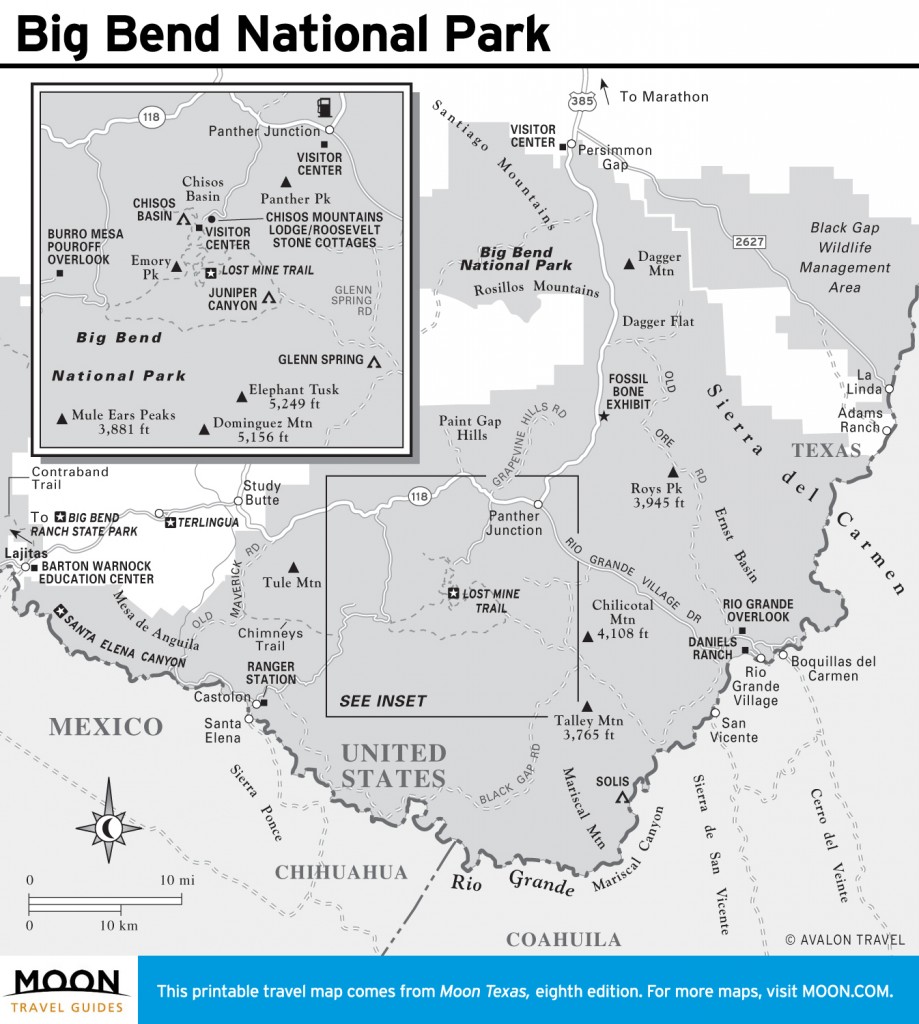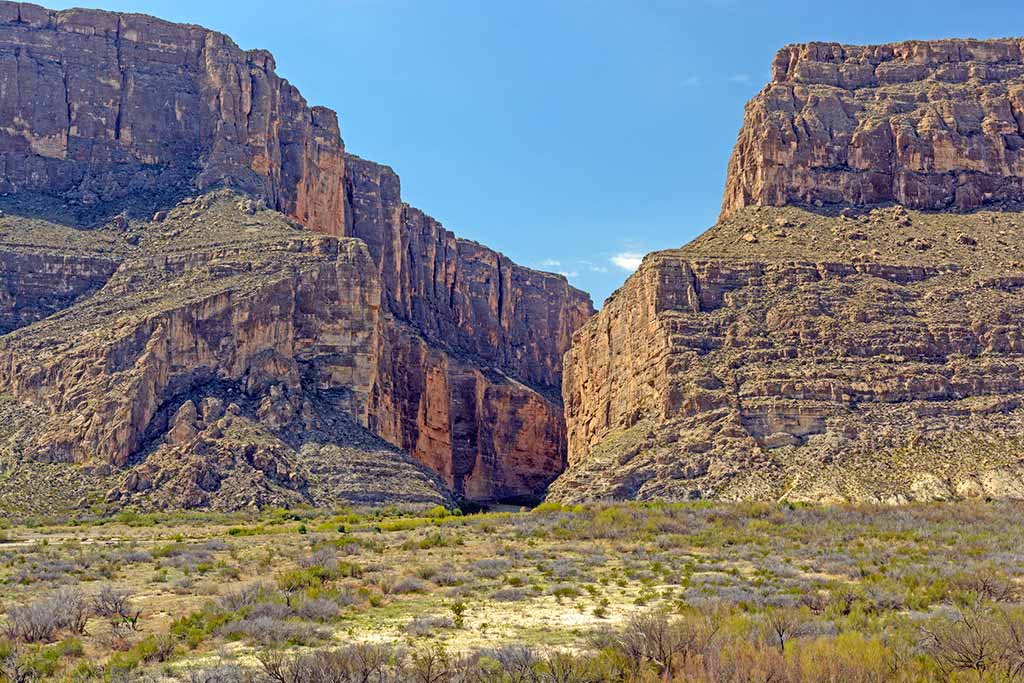Big Bend offers more than 200 miles of hiking trails ranging from short, easy nature walks to primitive mountain trails for experienced hikers. There’s truly something for everyone here—families can take their time on moderate trails with printed interpretive brochures as a guide, while hard-core backpackers have the option of taking backcountry trails into the desolate wilderness for challenging treks at their own pace.

Big Bend National Park
Talk about dramatic. You can see the massive walls of Santa Elena Canyon from miles away, but the effect of witnessing these sheer cliffs—more than 1,500 feet high on each side of the surprisingly narrow gap forged by the Rio Grande—is utterly mesmerizing up close. And it only gets better as the trail progresses. It’s a 1.6-mile trek, so plan about two hours to fully appreciate the experience. You’ll be drawn to the wide swath of river flowing from the massive canyon walls, but the difficult-to-find trail entrance will be off to your right. Look for the crude stone pathway across the shallow creekbed (your feet may get a bit wet), which leads to the trailhead. You’ll encounter a series of tight switchbacks and concrete steps before ascending a rocky trail that eventually descends into the canyon. When you reach the end of the trail, you’ll be surrounded by the stunning vertical cliff walls, which echo with the sounds of birds and kids (even adults) playing in the water. This is one of the few places in the park where swimming is safe and generally tolerated.

Santa Elena Canyon in Big Bend National Park. Photo © Steven Prorak/123rf.
Note: In late summer/early fall (after the “rainy” season drops up to a foot of moisture on the park), there will be more water in the Rio Grande, which affects access to the Santa Elena Canyon trail. Instead of being able to walk across the stone pathway, you’ll be faced with the not-very-recommended option of wading through several feet of murky water to get to the trail. Never fear—you can still get a sense of wonder just from being at the base of canyon, but you won’t get the full experience of being within sheer cliff walls. There’s always next time….
If you’re staying at Chisos Mountains Lodge, this is an ideal trail for a nearby morning hike. The cool temperatures are invigorating, and the scenery is stupendous. Considered one of the ultimate Big Bend hikes, Lost Mine Trail offers an ideal combination of moderate grades, a wide range of vegetation, extraordinary vantage points, and a handy interpretive brochure at the trailhead. If you happen to be at the park in late summer or early fall (following the summertime rains), you’ll get the bonus experience of seeing the Lost Mine Trail’s environs in a mini growth spurt with plenty of subtle colors and emerging flora. Look for red, yellow, orange, and blue blossoms on bushes, trees, cacti, and stems around every bend. Be sure to take a few minutes to stop hiking and do a 360-degree turn, absorbing all the fresh-green growth of new leaves and blooming cactus. If you look (and listen) closely, you’ll identify unfamiliar insects buzzing over new flowers, completely unaware of your presence.
![Casa Grande rising above the Chisos Lodge in Big Bend National Park. Photo © Yinan Chen [Public Domain], via Wikimedia Commons.](https://www.holidaytravel.cc/Article/UploadFiles/201602/2016021615535439.jpg)
Casa Grande rising above the Chisos Lodge in Big Bend National Park. Photo © Yinan Chen [Public Domain], via Wikimedia Commons.
The trail’s 4.8-mile round-trip (roughly four hours) will get you back in time for a much-needed hearty lunch at the lodge’s restaurant just a mile down the road. Those looking for a shorter venture are in luck: The most incredible view along the trail (and perhaps in the entire park) is about a mile into the trek—find a comfy rock to lean against and absorb the magnificent far-reaching view of Juniper Canyon. The untouched vista is absolutely mesmerizing—soak up the hundreds of miles of undulating terrain that’s offered the same panoramic scene for fortunate viewers for thousands of years.This short excursion will introduce you to just about everything you’ll need to know about Big Bend. It’s just under a mile round-trip, but set aside an hour to fully absorb the dramatic vistas and desert intricacies. The trail starts in a somewhat bizarre fashion, with a boardwalk crossing over a body of water originating from the wetland natural spring. It’s a strange sight to see, especially since it’s immediately followed by a hot and hardscrabble trek across rocky terrain among myriad cacti and desert scrub brushes (a handy guide at the trailhead provides interesting information about the different plants). The highlight is the view from the top of the moderately sloped hill, where you’ll find sweeping vistas of the Rio Grande and Mexico. Look for the blocky bright-white adobe buildings about a mile away in the Mexican village of Boquillas. The mighty Chisos Mountains loom in the background, presiding over a natural scene that is unlike any other you’ll experience.
Once visitors have experienced the awe-inspiring day hikes, they often feel compelled to take things to the next level. A popular follow-up excursion is to one of the backcountry campsites in the High Chisos Mountains along the trail system to the South Rim. These campsites, varying from one to eight miles each way, are accessible only by foot, and most involve an overnight trek.
For these trips, an overnight backcountry permit is required ($10), available only in person up to 24 hours in advance at all park visitors centers. Park staff can assist you with trip planning based on your needs and current trail conditions.
At 14 miles in length, the South Rim trek takes at least eight hours to complete. The Laguna Meadows trail traverses a dense forest popular with birders thanks to the abundant oak, maples, junipers, and piñon pine. Be sure to bring plenty of water (at least a gallon per person daily), food, sturdy shoes, and sunscreen.
![The intersection of the Laguna Meadows and Pinnacles trails below Emory Peak in Big Bend National Park, Texas. Photo © Fredlyfish4 (Own work) [<a href="http://creativecommons.org/licenses/by-sa/3.0">CC BY-SA 3.0</a>], <a href="https://commons.wikimedia.org/wiki/File%3ATrail_junction_and_Emory_Peak.JPG">via Wikimedia Commons</a>.](https://www.holidaytravel.cc/Article/UploadFiles/201602/2016021615535573.jpg)
The intersection of the Laguna Meadows and Pinnacles trails below Emory Peak in Big Bend National Park, Texas. Photo © Fredlyfish4 (Own work) [CC BY-SA 3.0], via Wikimedia Commons.
Another popular backpacking trip is to the Emory Peak campsite, 3.7 miles from the trailhead via the Pinnacles Trail. Since it’s the highest elevation in the park and therefore a quest to be conquered, Emory Peak is a natural draw for many hikers. Not surprisingly, it’s rocky and steep, but the payoff comes in astounding views of Boot Canyon and the back face and summit of Emory Peak.Many people travel to Big Bend for the amazing camping opportunities (more about those in a bit), but others just want to experience the great outdoors during the day with a reliable roof, walls, and bed frame surrounding them at night. Fortunately, the park offers the Chisos Mountains Lodge (432/477-2291, rooms average $135). Situated nearly a mile high in a cozy little basin surrounded by mountain peaks, the lodge offers a no-frills experience befitting of its remote and rugged location. The two-story lodge buildings are thankfully unremarkable in appearance and amenities, prompting guests to spend most of their time on hiking trails or on the sparse porches. In fact, one of the lodge’s best amenities is its lack of a TV—you may have to read a book or (gulp) just talk to your fellow travelers while sipping on a tequila or glass of wine. The rooms include tile baths, tubs, and showers; hair dryers; coffeepots; refrigerators; microwaves; and housekeeping service, so you don’t have to worry about being too far removed from the comforts of modern civilization.
If you plan far enough in advance (almost a year ahead of time), you can snag a coveted spot in the park’s premier accommodations: the Roosevelt Stone Cottages (432/477-2291, $147). These five stone cottages are removed from the hub of activity at the main lodge, and each cabin features stone floors and three double beds, showers, hair dryers, coffeepots, refrigerators, microwaves, and ceiling fans (no a/c is available, which isn’t usually a problem at this elevation). The cabins are highly recommended, since it’s likely you won’t be out here very often and the appeal of staying in your own private quarters in this beautiful park is unparalleled. These historic (1940s) cottages are oozing with mountain character, from the regional art and photos on walls, to the welcoming porches, to the big windows that capture a nice gentle breeze. Keep them open at night for perfect sleeping weather—you won’t even need to turn on the ceiling fan.
The park also offers three developed campgrounds—Rio Grande Village, Chisos Basin, and Cottonwood Campground (877/444-6777, sites average $10 plus service fees) for tent camping, trailers, and RVs. Rio Grande Village, on the far eastern edge of the park among trees (and Lodge Restaurant (432/477-2291, daily 7am-10am, 11am-4pm, 5pm-8pm, $8-18). Fortunately, the food here is much better than expected for a remote national park, with a surprisingly varied menu offering regional fare (Tex-Mex, prickly pear cactus sauces, etc.), standard dishes (sandwiches, pastas), and hearty breakfasts to fuel a long morning trek. “Hikers lunches” are also available as to-go options. The views of the mountains (particularly The Window formation) are stunning through the floor-to-ceiling windows, and it’s always nice to know a decent meal is available daily with enough variety (along with beer and wine) to make things interesting for several days’ worth of eating.
Excerpted from the Eighth Edition of Moon Texas.